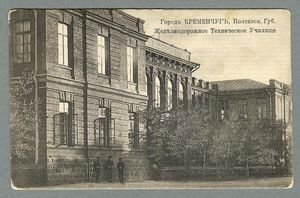In 1878, in connection with the needs of the Kharkov-Nikolaev railway, the Kryukov Society privately opened the Kremenchug Railway Transport College under the name of the Kremenchug Technical School. At first, the school rented a room, and since 1880 moved to a house built at the expense of the school fund on the street. Food (now Shevchenko St.) No. 10.
The school was one-complete with a three-year term of study. The first years of the existence of the school, it was headed by a technologist of the 1st category Voskoboinikov M.G., approved by the Minister of Communications as the head of the school on July 26, 1878.
In addition to the head, the staff of the school included 13 teachers and 2 masters. For three years, the pupils studied subjects: the way, movement, traction, communication, civil engineering.
There were no general education subjects in the school. It was believed that the knowledge provided by two-year general education railway schools with a 5-year term of study was sufficient. The school had a hostel for 60 pupils. Groupings were noticeable in the hostel – compatriots: Poltava, White Poles, Romodan, Sumy, Roman, etc. The vast majority of students spoke Ukrainian among themselves, although no one knew Ukrainian letters: it was forbidden in the school.
In 1904, the construction of a new house on Novo-Oleksandrovskaya Street (now Leonova Street, 14) was completed, where the school was transferred. The new premises made it possible to deploy parallel classes, thanks to which the graduation of 1906 was already 53 people. The school was almost a military regime. The whole life of the students was limited by the rules and instructions in the barracks manner: military restraint, uniform, guards, who were recruited from former military personnel.
Pupils were supposed to greet teachers in a military way, and when meeting with the head of the school, they were to freeze “attentively”. Departure to relatives, going out to the city, visiting the theater, cinema was allowed only with the written consent of the chief. Every morning we marched in formation to prayer, as well as to the dining room, church, cathedral, for a walk, etc.
There was not a shadow of familiarity in the relationship between students and teachers. There has always been a clear line between students and teachers. Until 1905, students were addressed with “you”; later on “you”, and strictly adhered to.
The teachers were only men, not a single woman. Even the employees (uncles) – porters, cleaners, cooks – were only men. Educational work in the school was based on thoughtless drill, blind obedience, the fulfillment of the Law of God. Books for reading were only allowed to be borrowed from the library, although there were only single works of art and textbooks that had been censored. Pupils were accustomed to physical work, self-service. Cleaning classes, training workshops, bedrooms was the responsibility of the students on duty. For violation of the rules there were punishments: a ban on walks, a punishment cell, expulsion.
This harsh regime was broken with the appointment in 1906 of the head of the school, Diebold Robert Robertovich, a Russian German who taught mathematics. He had a university education and the title of candidate of mathematical sciences. He belonged to the harsh, but very fair bosses. Restrained, a little detached from the outside world, he never shouted, did not fuss, was not verbose, but everyone feared and respected him: both students and staff.
Orchestras (brass and strings), drama and choir circles were organized, they learned to dance, which was considered a very prestigious business. Evening parties were arranged to which guests were invited. Ballroom dancing, especially the waltz, was held in high esteem. Everyone knew how to dance, and some even very well. Physical education was not given much attention. In the lessons they used a horizontal bar, a pole, bars. They taught fashionable then “Sokol gymnastics”. Under the count aloud of one of the participants, they made “pyramids”, sports figures, etc. Football began to come into fashion. In 1912, KTU already had a fairly well-known football team, which more than once won meetings with the Kremenchug real school.
Another attitude was to military training, which in the educational institutions of that time (and especially such as the technical railway schools of the semi-closed type) was given very great attention by the government.
The First World War was approaching. The threat of war required the training of military personnel. For this, the situation in KTU was favorable. The outward sign of this was the form, the control over the correct wearing of which was relentless. This alone, as the students believed, tightened and disciplined.
In 1911, on July 28, the All-Russian review of the so-called “amusing troops” took place in St. Petersburg. It was one of the measures of the tsarist government, aimed at testing the preparations for the war. From the Kremenchug School, in addition to a platoon, there was also a team of wind
orchestra (23-25 persons). Military training was not weakened at the school in the following years.
In June 1912 at st. Lozovaya held a re-training of the “amusing” ones. And after 2 years, many of them already gave their lives on the fronts of the First World War.
Somik M.I., Somik Ya.V.
Materials of the scientific – practical conference “Kremenchuk – 435 years”

